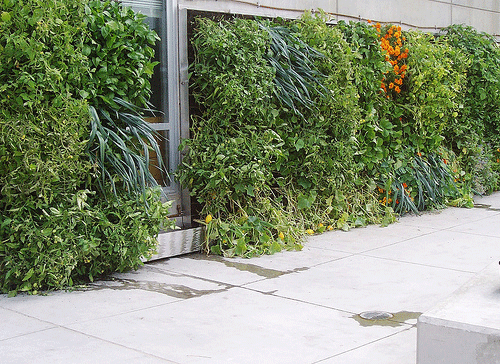
If you have not already noticed, living walls (green walls) are on the up. It is the latest growing trend in horticulture and architects, designers, building owners and tenants are already embracing this new planting method to help them green up their living and working environments, especially where horizontal space is of a premium or even completely unavailable.
So, it comes as no surprise that the next step would be to make a living wall an edible wall, so you not only benefit from all the health benefits associated with plants, but also start to grow some of your own food and get a financial return from your investment.
We have already had some customers enquire about using vertical space to grow herbs to help supply their on-site kitchen and help lower their carbon foot-print. So why not take this one step further and consider growing a wider range of food?
If developments outside the UK is any indication, where landscapers are now offering edible walls and roofs as wells as backyard farms as an alternative landscape for the residential sector, then this idea will also shortly become commonplace in the UK.
There are already amateur and professional products on the market like strawberry hanging bags, which prove the theory that edible crops can be grown vertically. So, if we widen our vision, we soon realise that we can also consider growing the some of the following in the same way:
- Herbs
- Salads
- Peas
- Beans
- Courgettes
- Aubergines
- Cucumbers
- Strawberries
- Dwarf tomatoes
- Peppers
- Chillies

There are various systems on the market, but they generally all work on the same basis: they are modular, so they can be adapted to fit most spaces from as small as 50cm2 up to as tall and as wide as you can imagine. These modules are then fixed to the permanent or temporary wall in front of a waterproof membrane using fixings and spacers to keep a void between the modules and the wall.
The modules either have planting pockets incorporated to allow a lightweight and open growing media to be added or they have space for sheets of a hydro-cultural product like ‘Grodan’ rockwool to be inserted.


You should consider using small plants where possible when planting your living walls, they are cheaper, easier to plant, establish quicker and, once established, you can start harvesting when available. You may also want to consider extending your harvest period by staggering the time of planting.
Irrigation
On large or commercial walls, we highly recommend incorporating an irrigation system (which is not effected by hose-pipe bans), as living walls require water on a little and often basis, which will reduce the amount of water run-off. On smaller residential applications, you may be able to get away with manual watering in the same way. You will need to consider that both methods will have water run-off. It may be that you can deal with this with a simple discrete evaporation tray on the smaller applications, but on the larger applications, you will need to consider managing this run-off into a nearby drain.
Care
If you want to do it yourself and already have experience with growing your own food, be it some potted herbs or a vegetable plot, then migrating to a living wall will be a breeze. If you are not but want to learn, there are plenty of small-scale products that you can cut your teeth on. If you have a commercial interest, there are plenty of landscape companies like ourselves who offer design, installation and maintenance options.
So why not look at what spare vertical space you have and consider incorporating an edible living wall.